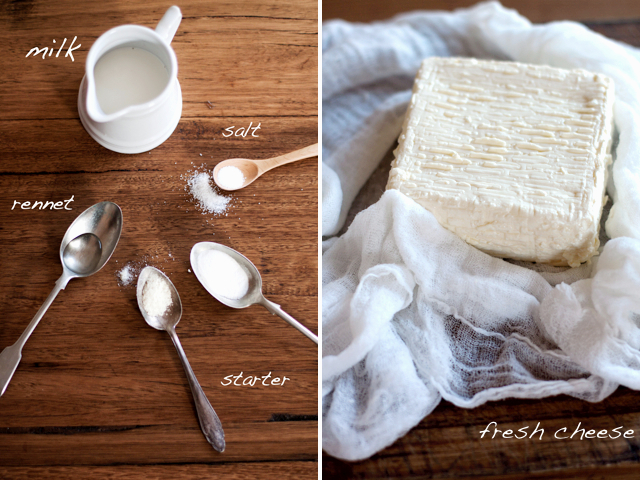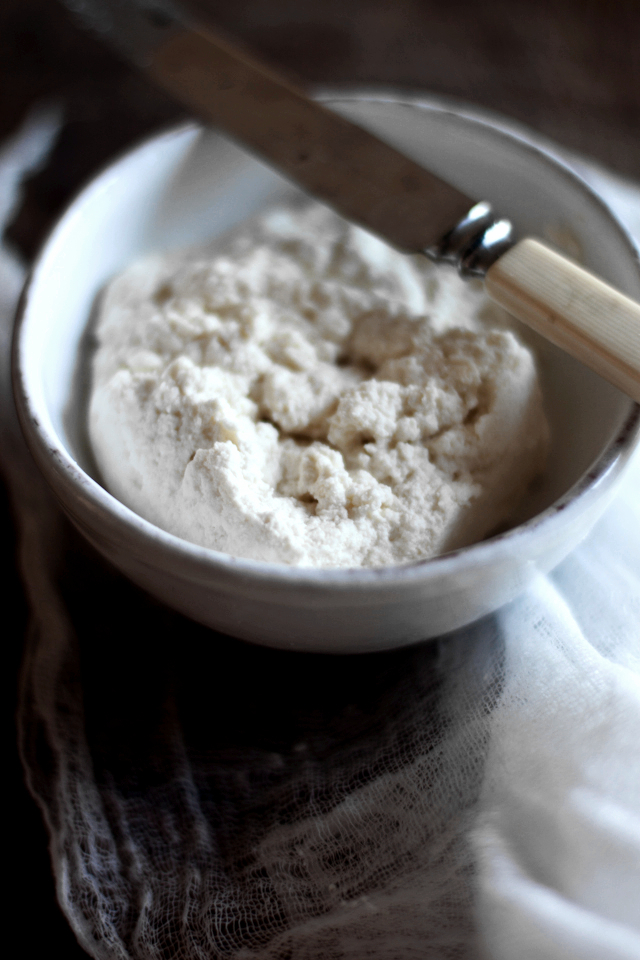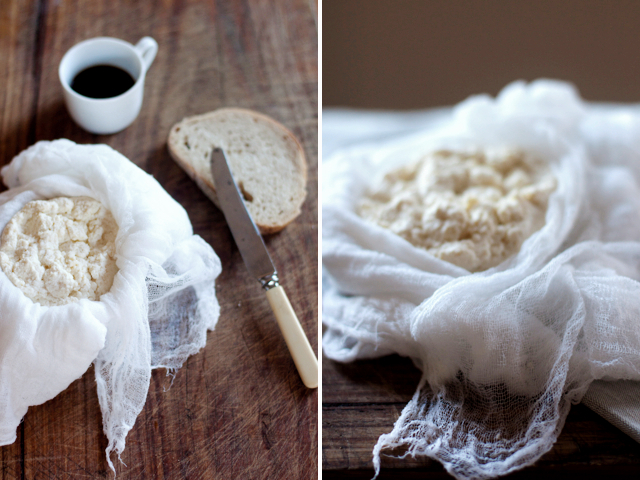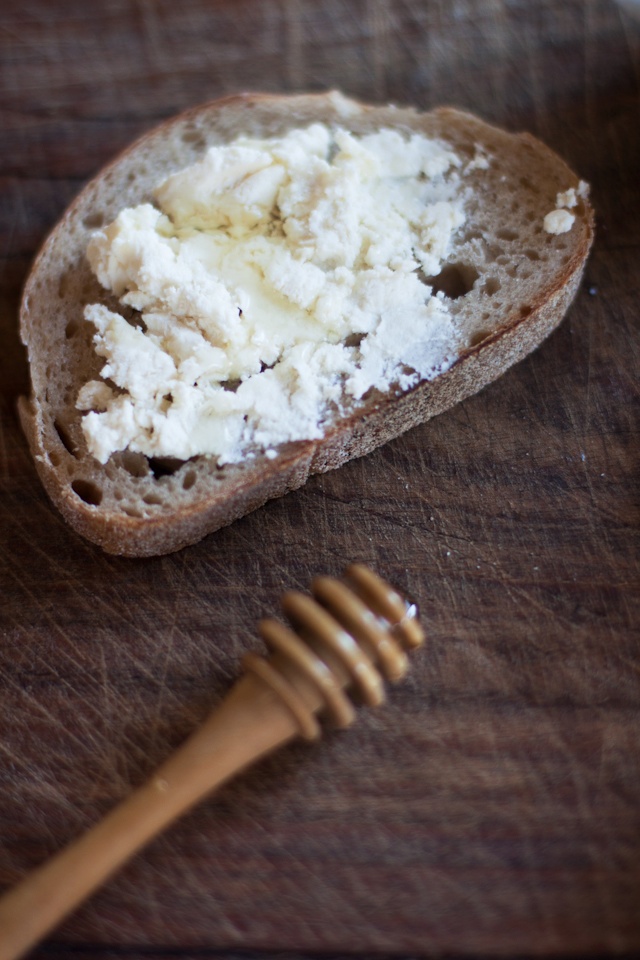There is something magical about the process of cheese making; the same kind of magic that I witnessed when I developed my first photograph in the darkroom and watched an image appear from seemingly nothing. In both cases, it was love at first sight.
Ricotta is not technically a cheese but a milk product or a by-product of the cheese making process, like its Lombard cousin, mascarpone (whose name by the way in its local dialect means “ricotta”) and is a good example of how good Italians are at inventing ways to not waste food. Its name, like many fantastic Italian food words, describes exactly how it is made: it is “re-cooked”.

While recently testing out a home fetta-making kit with cheese experts, Rebecca of The Curd Whey and Irina, the editor of The Cheese Mag, I jumped on the chance to make use of the potful of leftover whey after the curds had been collected and drained in their little baskets (the cheese we made is in the photo above). We re-heated the whey, added a touch more milk and a dash of vinegar. Watching the magic happen in the pot is a special thing indeed: fluffy, white specks magically collect at the surface of the pale straw-coloured whey, ready to be scooped out and eaten immediately.
Homemade ricotta is a delightful thing and there are many recipes claiming to be ‘ricotta’ but mistakenly describe a fresh curd recipe made from straight milk rather than actual ricotta, which is mostly whey. They’ve been popping up all over the place and in some of the most respected sources too (it’s one of the most popular recipes on Food52 and even Donna Hay magazine did a feature of a so-called ‘homemade ricotta’ recipe last October. There’s also this extremely detailed and researched article on Serious Eats). But none of these are ricotta recipes. Take the name itself: ricotta literally means “re-cooked” in Italian – where is the re-cooking here?
In fact, these recipes should simply be called ‘fresh cheese’ or ‘cream cheese’ as Elizabeth David does in her book Italian Food from 1954. For her homemade cream cheese, she instructs warming 4 pints of very fresh milk, stirring in 2 teaspoons of rennet and leaving it for a few hours for the curds to separate from the whey. She is careful to describe using it as a substitute for ricotta, pointing out that the taste and texture are quite different from real ricotta.
An almost-forgotten, rustic version of this ‘cream cheese’ also exists in the countryside of Tuscany and southern Italy known as cagliata con i rametti di fico (cagliata means curds, caglio means rennet), in other words, ‘fig branch curd’. A litre of milk, warmed and stirred with the bright young branches of fig trees (which as full of that milky white liquid that is a natural rennet) and left to separate creates a beautiful, thrifty and easy fresh curd. But again – Italians know better than to call it ricotta, it’s a curd.

Ricotta is one of those amazing foods that has changed very little since ancient times and that has made its way all over the diverse culinary peninsula of Italy. Bartolomeo Scappi, the Renaissance chef of the pope, served ricotta sprinkled with sugar and rosewater, or in tarts, both savoury and sweet. It’s used from the north, in regions like Piedmonte and the Alpine regions of Friuli-Venezia Giulia all the way to the southern tip of Sicily, where you can find some of the tastiest ricotta and ricotta recipes in the country. It’s made from the milk of a variety of animals: cows, goats, sheep (the favourite), even buffalo (in Campania the leftover whey of buffalo mozzarella is turned into ricotta – oh yes).
Ricotta is best eaten right when it is made, even standing over the pot, while still warm, if possible. There is a Renaissance illustration from the 1460s that show a woman stirring a vat of curds, while on the table next to a jug of wine and some bread is an already-turned out fresh ricotta and a man standing over it, heartily digging into it with a spoon. This to me illustrates perfectly my ideal way to eat ricotta – immediately and as fresh as possible.
The standard industrial version of ricotta that you can find in supermarkets is a far cry from what this product should taste like. Being such a simple recipe, tasty, quality milk is undoubtedly the most important ingredient. Industrial ricotta will usually be made from UHT milk, which, as you can imagine, is a completely different product from that made of fresh sheep’s milk, straight off the farm.
The problem is that fresh ricotta doesn’t travel well and it’s not meant to last – unless of course we’re talking about the ricotta salata or ricotta forte of the southern regions of Puglia, Abruzzo, Campania and Basilicata: smoked, salted and aged versions that have a following of their own. Grated on pasta dishes, these cheeses have the ability to transport you directly to cheese heaven. The ricotta forte of Puglia is a spicy, creamy, pungent thing that will knock your socks off; the smoked ricotta of Calabria is eaten either fresh or a month later, grated, while the ricotta affumicata of Abruzzo is a thing of beauty smoked over juniper wood.


For this ricotta recipe, which is adapted from the Home Cheesemaking book by Neil and Carole Willman, you will need to begin with a potful of whey that you’ve just made some lovely fresh cheese from and a thermometer to measure liquids (that you’ll no doubt have if you’ve just made cheese). You will get an amount that is about the same weight as the milk that you add. This can easily be doubled or adjusted to other measurements (it’s simply 10% of the amount of whey in milk).
A quick note on the milk: this is the important stuff. For a tasty, interesting, full, rich ricotta consider the types of milk you could get for making this at home. I won’t go into the whole raw milk thing because it’s not accessible to many people but there is certainly much to be said about it – in Tuscany we were users of the raw milk dispensers (much like a soda machine) on the side of the road where you can buy 1 litre of that day’s raw milk for 1 euro! But I will say try to use whole, unhomogenized organic milk. You can choose between goat’s or cow’s milk (even sheep if you can find it – obviously this is the milk of choice in Tuscany). A few things to consider: cow’s milk is sweeter than goat’s or sheep’s milk and goat’s and sheep’s milk is fattier, giving a rounder, richer taste.
Ricotta
- 2 ½ litres of leftover whey
- 250 ml of unhomogenized, whole organic milk
- a pinch of salt
- 20 ml of white vinegar, diluted in some water
Heat the pot of leftover whey on a low-medium heat. When it reaches 60°C, add the milk and the pinch of salt. Stir constantly with a wooden spoon and turn up the heat slightly watching for it to reach 95°C (though my Slow Food manual on cheese making, Le Forme del Latte says it should be between 82-90°C). Add the vinegar while stirring constantly and quickly. Take the pot off the heat and let the whey sit for 5 minutes before scooping out the ricotta with a slotted spoon into a strainer lined with a muslin cloth.
The longer you leave it to drain, the firmer and more crumbly it will become, but it is literally ready to eat as soon as you take it out. It is naturally sweet (especially if you have used cow’s milk); you can add extra salt to it at this point if you prefer your ricotta for savoury use. I recommend eating it immediately, smeared onto a thick slice of toasted bread with a drizzle of honey.
If you want to conserve it a bit longer, try ricotta infornata, baked ricotta: add salt (even herbs if you like), place the ricotta in a greased ramekin or tin and bake it until browned all over and firm – delicious in sandwiches or simply on its own with extra virgin olive oil and sea salt.
To find out more about ricotta and Italian cheese making in general, I highly recommend the Slow Food cheese manual, Le Forme del Latte if you read Italian. Otherwise, visit your local farmers who make cheese and may have a cheese making lesson or tour available. In Tuscany, the most beautiful place for this has got to be Il Podere Il Casale – rustic, organic and genuine.
In Victoria, Australia, Rebecca from The Curd Whey blog has compiled this tidy list of places to learn more about cheese. If you have any good suggestions in your home town or area, feel free to let me know or add it below!




Comments
Simply stunning photos, as always, and now you’ve inspired me to make my own cheese! I’ve made butter before and absolutely agree, you need to start with incredible milk to make the process worth it.
And you should make your own cheese! It’d go so well with your beautiful bread! There are couple of links floating around in these comments on cheese kits and such if you want to check them out 😉
Fascinating piece on ricotta and lovely photos. A great place to learn about cheesemaking in England is http://www.schoolofartisanfood.org/short-courses/dairy/
I’ve been researching a regional dish using curds so this piece particularly interested me.
Thanks for sharing that link Evie! Regional curd dishes, eh? Sounds very interesting, we could probably swap some notes! 🙂
Really fascinating. Ricotta home made. It sounds great on home made bread. I hope to do it someday.
Thanks a lot for your really complete explanation
It makes the best breakfast ever! Thanks Rossella!
beautiful post!!!
I tried making ricotta recently but failed, I will try again!
Hi Regula! I have to admit, the first time I tried it, it didn’t work out either but I think we were a bit ambitious after a visit to our favourite cheesemaker revealed that he doesn’t add any extra milk to his ricotta, he just simply re-heats his whey and there it is! (it’s also some of the yummiest ricotta ever, BUT he uses super fresh, raw, organic sheeps’ milk from his own sheep so that no doubt makes a difference!). Using a store-bought, pasturised cow’s milk in the original cheese I think you definitely need to add extra milk to the whey to get any result.
Hi darling, I used raw cows milk from the farm near our house. It worked but I made a different kind of cheese as I lost too much whey. It was good but no Ricotta 😉
Oh no, I think not having a large enough portion of whey is very likely a reason for the ricotta not turning out – you do need a large amount of it even to make a small portion of ricotta. That’s too bad! Hopefully it works out next time!
all good except, how do you get the leftover whey?
Good question; do you know a cheese maker?
Is there a way to make the left over whey ourselves? Is it produced making any type of cheese? Do you know if this amount of whey is produced from e.g. making one ball of mozzarella or would it be accumulated from a large quantity of cheese?
Normally whey is the by-product of cheesemaking (yes, any cheese, mozzarella or pecorino is typical) made from milk and rennet, but you could also make ricotta with milk and rennet too. Calabrian-American cookbook author Rosetta Costantino has a good recipe for that on Cookstr: https://www.cookstr.com/recipes/homemade-ricotta-2
A fantastic recipe! I’m bookmarking it. Your ricotta looks perfect.
Cheers,
Rosa
Thanks Rosa, I hope you get to try it out. Let me know what you think!
I’m so glad you wrote this! I’ve been thinking the same thing for a while now, noticing all the homemade “ricotta” recipes online. I look forward to trying this recipe using leftover whey.
Thanks, I’ve had this in the works for quite some time now, finally managed to get it out there! Let me know how it goes when you try it!
Well said, Emiko! Step back fake versions, this is what ricotta really is, and no fancy name or design label cake turn plain fresh cheese into ricotta!
I love ricotta and I will definitely give it a go! But what is leftover whey? Sorry for the stupid question….
Francesca, whey is called ‘siero’ in Italian – when the milk coagulates, it separates into curds (cagliata) and the liquid (siero). The curds is the cheese, that then gets drained until it’s the right firmness and depending on the cheese, probably put in a brine. The whey is often thrown away but there are loads of uses for it. In places where they make a lot of cheese, like Switzerland, it’s often used as a refreshing beverage or a sport’s drink (it’s full of protein). You can also re-use it to boil pasta in or water the plants (that don’t mind a bit of acidity)…. or you can make ricotta from it!
Thank you Emiko! Is it easy to find whey? I’ll start my hunt.
Francesca
I’m not sure you can buy it, but if you know someone who’s making cheese and isn’t using the whey, you could ask them! Otherwise, why not try making your own cheese (there are links to cheese kits and cheese classes among the comments) and use the leftover whey for ricotta – you end up with 2 cheeses that way!
Sometimes I make a fresh cheese by straining yoghurt in a cheescloth for a day. Can I assume that I could use the leftover whey from that process for ricotta?
Hi Samantha! Actually yogurt is a different product from cheese – it is simply milk fermented with the help of healthy bacteria. So you can’t use the leftover liquid from draining yogurt. But if you make a simple cheese with milk and rennet (this is what coagulates the milk) then the leftover whey from that process is what you can use. It’s a liquid that is rich in proteins (that’s why it’s often used as a sports drink!). When the whey is reheated, the proteins break down (the addition of acid helps) and that’s essentially what the “fluffy” white specks of ricotta are! Hope this helped. If you want to try making cheese, there’s a wonderful shop that sells cheesemaking kits on Etsy that you should check out, she’s based in Oregon but ships all over: http://www.etsy.com/shop/UrbanCheesecraft
Thank your for spreading the word about real ricotta! Cream cheese is a nice treat as well, but it is not ricotta. I am always so jealous looking at your stunning pictures!
I absolutely have to try this next time I make cheese.
How much do you dilute your vinegar?
I added about the same amount of water, maybe a bit more – all done without measuring of course, as long as you have the right amount of vinegar you should be fine!
I’ve never made homemade cheese before but plan to do so soon. But how do you know how much mozzarella to make in order to yield a certain amount of ricotta? If I want 1 pound of ricotta, how much milk would I use to make mozzarella so I can then make the ricotta? And is it possible to follow your recipe but leave out the addition of milk or will that yield much less ricotta?
I have the same questions. Basically, if I use one gallon of raw milk to make mozzarella cheese, how much ricotta (approx) can I expect to get from the remaining whey. Thank you for these instructions!
It’s difficult to give an exact quantity since it often depends on the quality of the milk (how much fat it has), the acid used and how to determine the quantity. I’d estimate a small bowl full!
Thank goodness someone is out there showing people what real ricotta is all about. I grew up on it made from the whey left over from making the canestrato cheese from goat’s milk. Passing vinegar and milk off as ricotta is the norm these days on blogs. It is NOT the same thing.
Thank you! Glad you appreciated this, it’s something that has been bothering me for years!
Thank you Emiko! I have just made ricotta just using milk, lemon juice, and salt. I have now whey left and was thinking of using your recipe – how long can I keep the whey in the fridge before making it? I got the whey yesterday – a day is ok?
Thank you
Hi Emiko,
I’m visiting Turin and google isn’t helping me understand the differences between the following products. My local shop which sells only products of (Piemontese!) buffalo, offers all of them, so the difference doesn’t seem to be which animal’s milk is involved. I’ve also seen “primo sale cabra” offered next to to “primo sale muzza”…
I understand that Mozzarella has a different texture, but all of these cheeses have a very similar fresh milky taste. What is the purpose of making all of these varieties? What taste distinctions am I not getting? What are the uses?
• ricotta
• primo sale
• stracchino
• mozzarella
Thank you so much!
Violet
Hi Emiko,
Finally living with a fig tree and a nearby dairy…. Made the fig-rennet cheese using this link: https://ricette-utenti.cookaround.com/cagliata-con-rametti-di-fico.html. It worked.
Then followed your instructions here for ricotta, but it stayed liquid…
Does ricotta depend on a particular kind of rennet or lactic acid?
Thank you so much for all your inspiration!
Violet
Emiko,
very interesting, thank you for the information, very helpful. Could whey leftover from yogurt-making be used for making ricotta? I make a lot of yogurt at home and really hate throwing the whey away. Thank you.